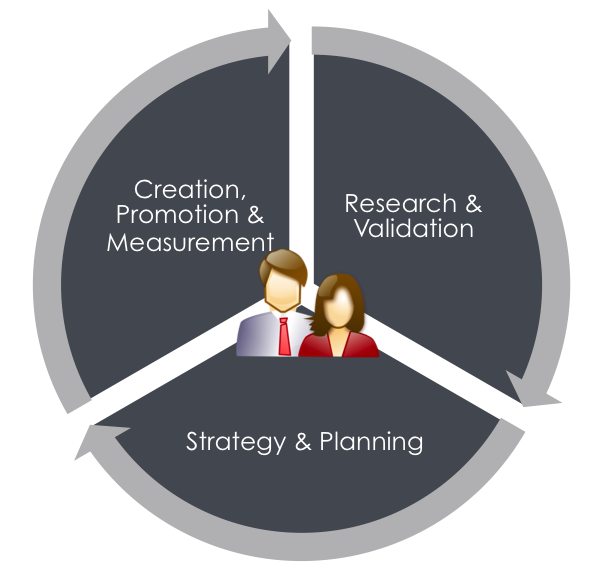The 3 Most Important Steps for Your Next Content Strategy Refresh
Among all companies with documented content strategies, only 36 percent say their content marketing is “very effective” or “extremely effective.” That means 64 percent are sitting somewhere, scratching their heads and wondering, what are we doing wrong?
Documenting your content strategy is great, but it’s not everything. Many documented content strategies don’t work because they’re not built around the company’s audience. An effective content strategy is audience centric – it literally needs to begin, keep coming back to, and end with the audience.
How can this be done? Fathom, a digital marketing agency in Cleveland, OH has experience moving from channel-focused marketing to an audience-focused
plan.
“Fathom has a great history of execution at the channel (SEO, PPC) level,” said Jeff Hermann, Fathom’s Chief Revenue Officer. “To fulfill Fathom’s own growth strategy, and to drive our clients’ growth strategies, we must take an audience first mindset.”
Here’s how to do it…
Phase 1: Do the Research
Before diving in to content creation, take the time to perform the necessary research and start gathering insights. Keep in mind that the key to an audience-centric strategy lies in what you’re researching. Do you start with a content audit that examines the gaps in your company’s website? No. An audience-centric content strategy starts with the audience – the market research. Who is talking about you online? What are they saying? And where are they saying it? This is a crucial first step.
Next you need to take these insights and bring your audience to life through customer personas. Make the central piece of those personas your audience’s pain points and motivations – not their demographics – since that’s the information you need to solve their problems through content.
With those customer personas in hand, it’s time to align problem-solving content to each persona and the different stages of the buyer’s journey. This ensures that every content idea you have is derived from your audience, their pain points and their journey through the buying cycle, rather than content that’s simply SEO-friendly or self-serving.
Phase 2: Use the Research to Set the Strategy
Next is the creation of your digital content strategy, which should be based on the information you researched in phase one. Remember – this strategy needs to cater to your audience. That means the first step is to create a content marketing mission statement that answers these three questions:
- Who is your core audience?
- What are you delivering to that audience?
- What is the outcome for your audience if they consume your content?
This mission statement is the core of every decision you make moving forward. If a content idea does not fit the mission statement, skip it.
Your next step is to figure out your audience story ideation. What stories do you want to tell, and more importantly, how do those stories benefit your audience? This is not about selling or blurting out value propositions, it’s about using stories to help your target customers. Those stories should focus on solving problems, educating, knowledge-sharing, informing, entertaining, and highlighting successes.
Phase 3: Create, Publish, Promote and Measure
Everything you’ve done up to this point has re-focused your content around your audience. Now it’s time to conduct a content audit/gap analysis to examine your existing content – but do it with your audience in mind. Does it speak to your audience’s needs? Does it need revised to be more audience-focused? If so, you can build what’s needed into your content roadmap.
The content roadmap guides the creation, publishing and promotion of your content. Who is responsible for creating each piece? What will the pieces be about? What are the goals, primary keywords and KPIs of each piece? Where and how will each piece be promoted?
The content roadmap should answer all of these questions in a format that works for you. DivvyHQ’s content planning and production platform might be the perfect tool for your content roadmap.
With this roadmap in hand, you’re now ready to create your audience centric content. When you hit ‘publish’, however, your job’s not done. For content to perform its best, it needs to be continually promoted, revisited and reworked.
Keep track of its progress by measuring the most important metrics (which can vary depending on what the content is. For example, a whitepaper may have very different success metrics than a blog post.)
At the end of this phase, take everything you’ve learned about your content (what worked and what didn’t) and incorporate those insights into a refreshed content roadmap. Always use what you learned for your next batch of content. Continually test and try new things. The entire content strategy is a never-ending process, regardless of the number of phases.
You Decide
Do you want to be a portion of the 36 percent of companies who say their content marketing is very effective? Make it audience-focused. An audience-centric content strategy ensures that your content is effective because it provides value to the right people at the right time in the right place. If your audience doesn’t see your content, or they see it but it doesn’t directly speak to them, it will never be effective.
Now it’s your turn to take the above pieces and try them for yourself. Will your company’s content strategy be more effective? Go find out.


